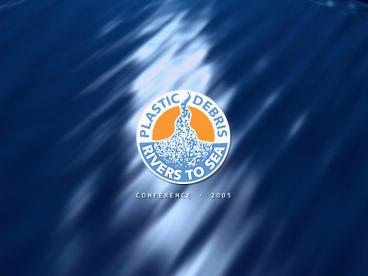San Gabriel River Debris Collection - PowerPoint PPT Presentation
1 / 47
Title: San Gabriel River Debris Collection
1
(No Transcript)
2
(No Transcript)
3
The ProblemBallona Creek November 2001
4
Problem Definition
- Floating and Positively Buoyant Debris Washing up
on Seal Beach - Impacts
- Visual Amenity
- Water Quality
- Costs
- Collection
- Removal
- Disposal
5
Solution ???
- Source of Debris at Seal Beach is primarily the
San Gabriel River Watershed - Install Debris Collection Device in the River
6
San Gabriel River Debris ControlDesign
Considerations
7
Design Considerations
- Location
- Debris Characteristics
- Quantity of Debris
- Method to Catch Debris
- Storm Event Flows (1y, 2y, 5y)
- Hydraulic Impact
- Maintenance
- Safety
8
Location
- Concrete channel for ease of operation
- easier to remove trash
- no navigation issues
- Downstream San Gabriel River, Coyote Creek
confluence - Upstream Fullerton Creek, Coyote Creek, Coyote
Creek North Fork confluence
9
Location
Coyote / Fullerton / Coyote North
SGR / Coyote Creek
10
San Gabriel River
Downstream Sites
Coyote Creek
90 of debris load at mouth LACDPW nets in
place
11
(No Transcript)
12
11/08/02
02/12/03
13
Debris Collection Methods
- Floating Systems
- Nets
- Trash Rack
- CDS Stilling Basin
14
Floating System with Skirt
15
Floating Cage
16
Fixed / Floating Net
17
Removal
- Manually with rakes or pitchforks
- Crane and scoop with water in channel
- Front-end loader in dry channel
- Automatic conveyor system
- Eductor Truck
18
Manual Removal
19
Crane with Scoop
20
San Gabriel River Debris ControlDebris Net
Design
21
Proposed Design - A
22
Proposed Design - B
23
Proposed Design C D
Direction of Flow
24
San Gabriel River Debris ControlPhysical Model
Testing
25
Design Testing
- Static Analysis insufficient
- Learning from Existing Nets
- Physical Model Testing
- try a variety of designs
- vary the flow rate
- look at dynamic response to debris load
- optimize the design
26
Facility
- Canadian Hydraulics Laboratory, Ottawa
- High Volume Flume
Web Address www.chc.nrc.ca
27
Modeling Approach
- Construction of Channel in Flume
- Construction of Model Net Designs
- Selection of Debris Material
- floating, positively / neutrally / negatively
buoyant
28
Model Construction
29
Model Instrumentation
30
Existing Net
31
Existing Net
32
Existing Net
33
Existing Net
34
Existing Net - Summary
- Hydrodynamic Performance
- OK at low flows
- buoys and net submerged at medium to higher flows
- net held up in water column by tension in cables
rather than buoyancy of floats - Debris Capture
- OK at low flows, captures floating material
- can capture positively buoyant material
- High proportion (gt50) of neutrally buoyant
material lost under net
35
Cylinder Net
36
Cylinder Net
Large head-drop across net Back of buoys dry Held
in place by tension, not buoyancy
37
Cylinder Net
Flow over top of net Floating debris lost
38
Tetrahedral Net
39
Tetrahedral Net
Held up in water column due to hydrodynamic shape
rather than buoyancy
40
Tetrahedral Net
Balance of tension in 3 cables Get it wrong and
net tips over floating debris lost
41
Tetrahedral Net
Balance of tensions adjusted
42
Tetrahedral Net
Change the flow
43
Tetrahedral Net - Summary
- Hydrodynamic Performance
- OK at low med flows
- At medium/high flows, moderate head-drop across
net back of buoys dry - appropriate tension in tow cable and hydrodynamic
shape of buoys controls position in water column - Reducing area of net below the waterline lead to
improved net performance at higher flows - Can be difficult to balance tensions in three
cables - Debris Capture
- OK at low med flows, captures floating material
- can capture slightly positively buoyant material
- High proportion (gt50) of neutrally buoyant
material lost under net - At high flow, loses floating material but retains
captured neutrally buoyant material
44
Test D - Higher Flow
- Continues to be effective at higher flows
- Positively buoyant material in net assists in
keeping it afloat - Buoys act as spreaders
- More buoyancy and/or hydrodynamic lift would
assist keeping net above water level
45
Cylindrical Net - Summary
- Increasing downstream scoop very effective for
capture of positively buoyant material - As previously, tension in cables controls
position of Buoy in water column (rather than
buoyancy). However, increased buoyancy or
hydrodynamic lift would improve performance at
higher flows - Hinged gate assists in keeping net at correct
level in water column - Easier to balance tensions in two cables
(compared with tetrahedral system) - Loose net design may present maintenance
difficulties
46
Summary of Findings
- Dynamic Analysis Required
- Dynamic stability changes with flow and load
- KISS
- Simple designs are better
- Catch 22
- More effective the net at capture of positively
and neutrally buoyant material - greater
head-drop across net (ie upstream impact to
hydraulics)
47
San Gabriel River Debris ControlPostscript































